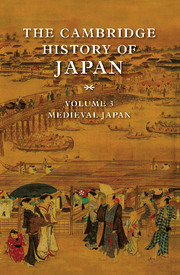Book contents
- Frontmatter
- Introduction
- 1 The Kamakura bakufu
- 2 Medieval shōen
- 3 The decline of the Kamakura bakufu
- 4 The Muromachi bakufu
- 5 Muromachi local government: shugo and kokujin
- 6 The decline of the shōen system
- 7 The medieval peasant
- 8 The growth of commerce in medieval Japan
- 9 Japan and East Asia
- 10 CULTURAL LIFE IN MEDIEVAL JAPAN
- 11 The other side of culture in medieval Japan
- 12 Buddhism in the Kamakura period
- 13 Zen and the gozan
- Works cited
- Glossary
- Index
- References
13 - Zen and the gozan
Published online by Cambridge University Press: 28 March 2008
- Frontmatter
- Introduction
- 1 The Kamakura bakufu
- 2 Medieval shōen
- 3 The decline of the Kamakura bakufu
- 4 The Muromachi bakufu
- 5 Muromachi local government: shugo and kokujin
- 6 The decline of the shōen system
- 7 The medieval peasant
- 8 The growth of commerce in medieval Japan
- 9 Japan and East Asia
- 10 CULTURAL LIFE IN MEDIEVAL JAPAN
- 11 The other side of culture in medieval Japan
- 12 Buddhism in the Kamakura period
- 13 Zen and the gozan
- Works cited
- Glossary
- Index
- References
Summary
The medieval centuries can fairly be described as the great age of Japanese Buddhism. Hōnen, Eisai, Shinran, Dōgen, Nichiren, Ippen, Rennyo, and thousands of lesser-known but equally dedicated religious leaders took Buddhism out of its traditional place in monastic cloisters under elite patronage, found new possibilities for personal salvation, and carried their message to common people throughout Japan. During these centuries, the foundations were laid for those new schools of Buddhism – Pure Land, True Pure Land, Nichiren, and Zen – that still claim the spiritual allegiance of the majority of Japanese. In response to these surges of reform, innovation, and popularization, some of the older schools of Buddhism produced reformers who called for a return to stricter monastic discipline and tried to make their teachings more accessible to ordinary men and women.
The social ramifications of this religious upsurge were enormous. Thousands, perhaps tens of thousands, of monasteries, nunneries, hermitages, and “training places” (dōjō) for lay devotees were established. Monasteries, monks, and wandering preachers looked for, and found, new patrons; received donations and grants of land; served as bearers of culture and learning as well as advocates of Buddhist spirituality; acted as political advisers; and engaged in commerce and diplomacy. Some of the older monastic centers remained powerful political and military forces in society. And some of the newer groups, especially the Nichiren and True Pure Land followers, displayed a militant edge.
- Type
- Chapter
- Information
- The Cambridge History of Japan , pp. 583 - 652Publisher: Cambridge University PressPrint publication year: 1990
References
- 2
- Cited by



